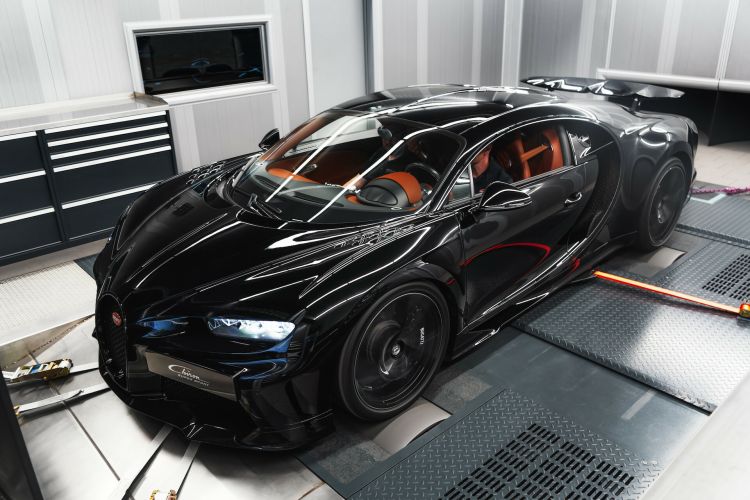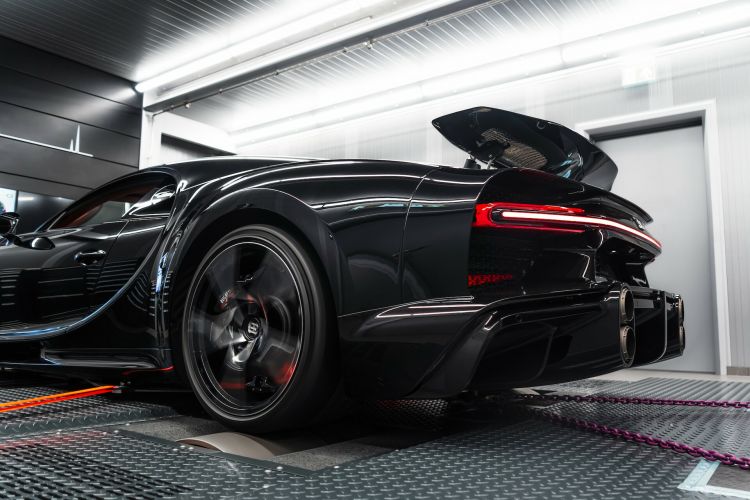Así es como Bugatti se aseguró de que el Chiron Super Sport alcanzara 273 MPH o 439 KM / H de manera segura
28 DE NOVIEMBRE DE 2021
Hacer
grandes afirmaciones de rendimiento para el primer superdeportivo de su nueva startup es fácil. Cumplir con esas afirmaciones es un asunto completamente diferente, algo que Bugatti nos recordó esta semana con un resumen del trabajo involucrado en la creación de su Chiron Super Sport de 273 mph (439 km / h).
El
Chiron Super Sport , como recordará, es una versión un poco más lujosa (y más lenta) del Super Sport 300+, que se convirtió en el primer automóvil de producción en superar las 300 mph (483 km / h) cuando
registró 304,773 mph (490,484 km). / h) en la pista de pruebas de VW Ehra-Lessien en agosto de 2019. Ambos autos comparten las mismas mejoras mecánicas sobre el Chiron original, pero el Super Sport simple está limitado a 273 mph (440 km / h) en interés de la paz mundial y la seguridad de las personas que vienen en sentido contrario.

Con los
primeros clientes de
Super Sport a punto de tomar las llaves, echemos un vistazo a algunas de las tecnologías que lo diferencian de un Chiron normal y veamos qué pueden esperar.
Más potencia, mayores RPM

Extraer
1578 hp (1600 PS) de un motor que ya produce 1480 hp (1500 PS) suena como algo que se resolvería con un par de pulsaciones de teclas en una computadora portátil, pero Bugatti amplió el tamaño de los cuatro turbocompresores, modificó los pistones y las válvulas. y elevó el límite de revoluciones del W16 de 8.0 litros en 300 rpm. El motor está rematado con un escape de titanio impreso en 3D con una estructura de doble pared que envuelve los gases de escape calientes con aire frío para mantenerlos alejados de las estructuras aerodinámicas de la carrocería trasera.
Engranaje más largo

Para aprovechar al máximo la potencia extra del motor,
Bugatti equipó al Chiron Super Sport con una séptima marcha 3.6 por ciento más larga. El SS alcanzó su velocidad máxima de 273 mph que destruye insectos en el séptimo lugar, después de haber pasado del sexto a 250 mph (403 km / h).
Cortinas de aire

Romper 270 mph sin aplastar el auto a la mitad de la recta requirió que los ingenieros de Bugatti crearan una forma con una resistencia mínima pero una carga aerodinámica significativa. Uno de
los trucos aerodinámicos de
Bugatti fue la adición de nuevas "cortinas de aire" en la parte delantera que ayudan a guiar el aire, asegurando que se adhiera a los contornos del cuerpo.
Un rápido nueve hoyos

Los nueve orificios circulares en las aletas delanteras del Super Sport hacen una buena referencia a una característica de diseño del
Bugatti EB110 , que fue brevemente el automóvil más rápido del mundo a principios de la década de 1990. Pero Bugatti dice que también son completamente prácticos, ya que permiten que la presión de los pasos de rueda se desvanezca y generen 20-30 kg (44-66 lb) de carga aerodinámica a 236 mph (380 km / h) sin agregar el tipo de arrastre que tendría. obtener de un spoiler tradicional.
Suspensión más rígida

La
carrocería de cola larga del Super Sport resultó en un cambio en la carga del eje, lo que requirió un aumento del 7 por ciento en la tasa de resorte trasero para mantener las cosas agradables y estables. Y quieres un poco de estabilidad cuando conduces más rápido de lo que pueden volar algunos aviones.
Ruedas ligeras

Bugatti ideó un nuevo juego de ruedas que pesaba (8.8 lb) 4 kg menos por juego que las llantas originales Chiron, y también eran más rígidas para sobrevivir a los rigores de una conducción de más de 270 mph. Y para los conductores que realmente quieren hacer un esfuerzo adicional (por hora), existe la opción de un juego diferente de llantas de magnesio del
Pur Sport que ahorran una enorme cantidad de 35 lb (16 kg).
Goma Michelin a medida

No puede exactamente bajar a Tire Rack y agarrar algo del estante cuando está haciendo un automóvil más rápido que casi cualquier cosa que se haya comprometido con el asfalto. Entonces
Bugatti hizo que Michelin modificara su neumático Pilot Sport Cup 2 para ofrecer más rigidez, pero también una suavidad adicional por encima de 261 mph (420 km / h), y los probó en una instalación diseñada para aviones de combate. Incluso toma rayos X de todos los neumáticos de producción para comprobar si hay defectos.
Para experimentar esta tecnología en acción, los
clientes de Bugatti se están separando con € 3,2 millones ($ 3,59 millones) para tener en sus manos solo un ejemplo de los 60 Super Sports que se están construyendo. O siempre puedes construir tu propio hipercoche de 273 mph. Quiero decir, ¿qué tan difícil puede ser?

Here’s How Bugatti Ensured The Chiron Super Sport Would Hit 273 MPH Or 439 KM/H Safely
NOVEMBER 28, 2021
Making big performance claims for your new startup’s first supercar is easy. Making good on those claims is a different matter altogether, something Bugatti reminded us of this week with a recap of the work involved in creating its 273 mph (439 km/h) Chiron Super Sport.
The Chiron Super Sport, you might recall, is a slightly more luxurious (and slower) version of the Super Sport 300+, which became the first production car to top 300 mph (483 km/h) when it recorded 304.773 mph (490.484 km/h) at VW’s Ehra-Lessien test track in August 2019. Both cars share the same mechanical improvements over the stock Chiron, but the plain Super Sport is limited to 273 mph (440 km/h) in the interests of world peace and the safety of people coming the other way.
With the first Super Sport customers about to take the keys, let’s take a look at some of the tech that differentiates it from a regular Chiron and see what they’ve got to look forward to.
More Power, Higher RPM
Extracting 1578 hp (1600 PS) from an engine that already makes 1480 hp (1500 PS) sounds like something that would be solved with a couple of keystrokes on a laptop, but Bugatti enlarged the size of the four turbochargers, modified the pistons and valves, and raised the 8.0-liter W16’s rev limit by 300 rpm. The engine is finished off with a titanium 3D printed exhaust featuring a double-wall structure that envelops the hot exhaust gasses with cold air to keep them clear of the rear bodywork’s aero structures.
Longer Gearing
To make the most of the engine’s extra muscle Bugatti fitted the Chiron Super Sport with a 3.6 percent longer seventh gear. The SS achieved its insect-obliterating 273 mph top speed in seventh, having shifted up from sixth at 250 mph (403 km/h).
Air Curtains
Smashing 270 mph without smashing the car up halfway down the straight required Bugatti’s engineers to create a shape with minimal drag but meaningful downforce. One of Bugatti’s aerodynamic tricks was the addition of new “air curtains” at the front that help guide the air, ensuring its sticks closely to the body’s contours.
A Quick Nine Holes
The nine circular holes on the Super Sport’s front wings make a nice reference to a design feature of the Bugatti EB110, which itself was briefly the world’s fastest car in the early 1990s. But Bugatti says they’re also entirely practical, letting pressure from the wheel arches bleed off and generating 20-30 kg (44-66 lb) of downforce at 236 mph (380 km/h) without adding the kind of drag you’d get from a traditional spoiler.
Stiffer Suspension
The Super Sport’s long tail bodywork resulted in a change in axle load, necessitating a 7 percent increase in the rear spring rate to keep things nice and stable. And you kinda want stable when you’re driving faster than some planes can fly.
Lightweight Wheels
Bugatti came up with a new set of wheels that weighed (8.8 lb) 4 kg less per set than the stock Chiron rims, and were also more rigid to survive the rigors of 270+ mph motoring. And for drivers who really want to go the extra mile (per hour), there’s the option of a different set of magnesium rims from the Pur Sport that save a massive 35 lb (16 kg).
Bespoke Michelin Rubber
You can’t exactly pop down to Tire Rack and grab something off the shelf when you’re making a car faster than almost anything that’s ever been committed to asphalt. So Bugatti had Michelin modify its Pilot Sport Cup 2 tire to offer more rigidity, but also extra smoothness above 261 mph (420 km/h), and tested them in a facility designed for fighter jets. It even X-rays every production tire to check for defects.
To experience this technology in action Bugatti customers are each parting with €3.2 million ($3.59 m) to get their hands on just one example of the 60 Super Sports being built. Or you could always build you own 273 mph hypercar. I mean, how hard can it be?






 y al 07:49
y al 07:49 























 (Minuto 2:45)
(Minuto 2:45)











